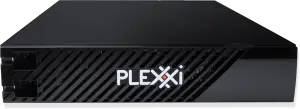Composable Fabric is the newest addition to HPE’s networking portfolio. Officially the branding given to the Plexxi acquisition, Composable Fabric is being billed as an integral part of the Composable Cloud concept. HPE announced two product forms for the Composable Fabric – one with SimpliVity HCI and the other on rack-mount ProLiant servers at HPE Discover last week in Mardrid.
The SimpliVity offering is the current GA version of Plexxi bundled with HPE SimpliVity 380 servers. The Plexxi provides basically a networking pipe for the HCI to run on and expand. Plexxi has a strong integration with NSX, so in some ways this offering is HyperConverged along with NSX plumbing.
For the Composable Cloud offering, the next generation of Plexxi with the official Composable Fabric branding is being released along with specific SKU’s of ProLiant DL380 servers. These servers are specifically designed to interconnect with the Composable Fabric switches running the PlexxiOS. These are the same whitebox switches that Plexxi has sold with the HPE nameplate on them. (See this related post about that solution.)
Let us dig into Composable Fabric and understand what it is.
Flat, Connected How you Want
Out of the box, HPE Converged Fabric switches will plug into one another and auto-create a broadcast domain. These switches will figure how they are related and you can cable them in any fashion that you want. Once you’ve completed the physical connectivity between switches, then you are able to attach to the new fabric using a controller VM. The controller is used as a management plane to define and create the networking profile that will run your actual workloads. All of these are software defined and that allows the system to reconfigure the underlying connectivity between switches on the fly.
The PlexxiOS allows you to ignore common problems that networking folks have been trained to pay attention to – like network loops. Not only will it allow multiple connections between switches without creating a problem – those multiple connections will be used actively and load balanced with traffic flowing across all links. Optimal and offering the best utilization of all links.
Reactive Recomposition
The PlexxiOS allows these network switches to react to problems within the fabric. If a switch or link fails, the underlying OS is able to dynamic recreate a new topology to continue operation. It is a built-in feature of the switches operating system to determine the state and react to changes or failures.

Interconnection
When I talked with folks on the show floor about interconnection, they assured me that all the normal border protocols would need to be configured and that your Composable Fabric would need to be connected to your Cisco gear onsite – or wherever your upstream traffic is served from. OSPF or BGP and the like are all still required to be defined for the interconnection with other networks.
In much the same way that NSX becomes a network overlay inside of VMware, the Composable Fabric is a self-contained and controlled fabric that can then interconnect with other networks. For many customers, they may choose to completely abandon the traditional switching stack and go to a flat datacenter network for growth and program-ability reasons, but for others, the Composable Fabric may be just one of many networks in their portfolio. Either way works.
More Info
To find out more, check out these resources – the official HPE Composable Fabric page and specifically the Video Webinar under Resources on the page.

